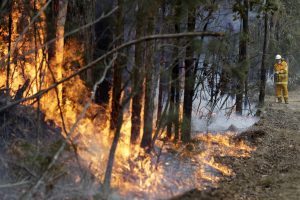Just nine months ago, during the height of a federal election, it seemed Australia was as divided as at any point in recent years. Morrison had won the “quiet Australians” with a pledge to safeguard the fossil fuel industry, while Labor won the cities with a promise to take decisive action on climate change.
But today, as bushfires have burned more than 12 million hectares, killed at least 26 people, killed or injured more than 1 billion animals and destroyed around 2,000 homes, Australians are unified in a way that transcends political allegiance. They’re are unified in grief, shock, and anger.
Trawling through social media platforms such as Twitter, Facebook, and Reddit, however, you might be led to believe otherwise, as lies and misinformation about the bushfires have spread as quick the fires themselves.
Dr. Timothy Graham a lecturer on social network analysis at the Queensland University of Technology assessed 1,340 tweets across 315 accounts using the hashtag #arsonemergency.
Using a Twitter bot detection tool, Graham found that around a third of the accounts displayed highly automated and inauthentic behavior and concluded that there is likely a current coordinated disinformation campaign taking place.
The hashtag derives from the idea that Australia’s disastrous bushfire crisis is the fault of arson, not climate change. It is true that according to police figures around 24 people have been arrested for allegedly starting fires this bushfire season, but many tweets have claimed that around 200 arsonists had been arrested in the state of New South Wales alone. Other tweets have claimed that left-wing ecoterrorists were responsible for lighting the blazes.
Graham says the motivation underlying these efforts often tends to not be changing people’s opinions about the bushfire itself, but to sow discord and magnify already existing tensions in polarized political issues.
“The conspiracy theories going around (including arson as the main cause of the fires) reflect an increased distrust in scientific expertise [and] scepticism of the media,” he told The Guardian.
“These are all major factors in the global fight against disinformation… It appears that Australia has for better or worse entered that battlefield, at least for now.”
Recent polls suggest that the environment is trailing closely behind the economy and health among Australian’s biggest concerns. This bushfire season has exacerbated those fears of global warming; reigniting the debate that simmered around election time – whether to continue relying on fossil fuels or to pursue climate action.
Despite a constant and steady stream of accurate information coming from fire chiefs and climate experts, misinformation has even found its way into national newspapers and on to broadcast news.
The New York Times has accused Australia’s largest media company, News Corp, and its owner, Rupert Murdoch, of attempting to influence the debate by arguing that this year’s fires are no worse than those of the past – a claim conservative members of government have since repeated and that climate scientists say is simply not true.
At the same time that Graham was making his research public, Newscorp’s national newspaper the Australian published a story reiterating that “firebugs” were responsible for the bushfires and claimed that “180 alleged arsonists had been arrested.”
The surge of misinformation prompted Victoria Police to release a statement: “There is currently no intelligence to indicate that the fires in East Gippsland and the North East have been caused by arson or any other suspicious behaviour.”
Newscorp papers have also been accused of simply trying to bury stories about the bushfires. As the New York Times reported, Melbourne’s Herald Sun pushed news of the bushfires to page 4 on New Year’s Eve, even as blazes threatened to devastate towns nearby and push thick smoke into the city.
Another popular narrative shared on social media is that the “greenies” or environmentalists are to blame for locking up national parks and preventing hazard reduction and fuel management.
“It’s not ‘dozens of firebugs’, it’s HUNDREDS! Climate activists are lighting fires in a desperate bid to amp up #ClimateChange fear. They should be jailed, along with the Greens politicians who incited them!” read a tweet by an account with several thousand followers.
This conspiracy has been carried all the way to the highest offices of government. As early as November, Nationals MP and former deputy prime minister Barnaby Joyce claimed that “greens policy” gets in the way “of many of the practicalities of fighting a fire and managing it.”
At the time, former NSW fire and rescue commissioner, Greg Mullins, wrote that hotter and drier conditions, and the higher fire danger ratings, were preventing agencies from carrying out prescribed burning and that “blaming ‘greenies’ for stopping these important measures is a familiar, populist, but basically untrue claim.”
Joyce has continued to spread misinformation though, appearing as recently as this week on a popular morning TV show.
“I believe, and this is my opinion, there are too many caveats that have been placed on people, let’s call them ‘green caveats’, that impede people’s capacities to fight fires.”
Rural Fire Service Chief Commissioner Shane Fitzsimmons was quick to dismiss Joyce’s comments, saying the agency was not compromised by “environmental bastards.”
“Hazard reduction burning is really challenging and the single biggest impediment to completing hazard reduction burning is the weather,” he said.
Adding to this myth was a picture that circulated online appearing to show that the Greens party changed its policies on bushfire risk management after the bushfires started, but an archived version of the same page from March 2019 shows the policy has remained unchanged since then.
The Greens party has made it clear that it supports hazard-reduction burns.
Responding to the New York Times, News Corp said: “Our coverage has recognized Australia is having a conversation about climate change and how to respond to it. The role of arsonists and policies that may have contributed to the spread of fire are, however, legitimate stories to report in the public interest.”

































